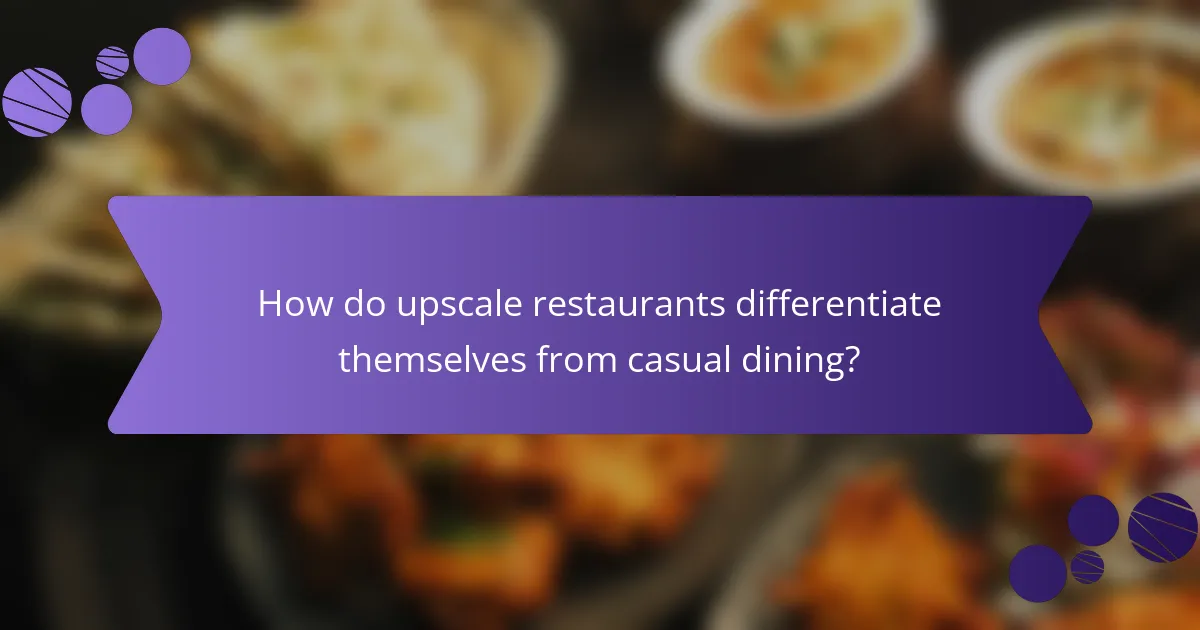
What defines upscale dining and its significance?
Upscale dining is defined by high-quality food, exceptional service, and an elegant atmosphere. It typically features gourmet dishes prepared with premium ingredients. The significance of upscale dining lies in its ability to provide a unique culinary experience. This dining style often emphasizes presentation and flavor. Upscale restaurants frequently offer a curated wine selection to complement meals. The ambiance is carefully designed to enhance the overall experience, often including sophisticated decor and attentive service. Such establishments often cater to special occasions and celebrations. According to the National Restaurant Association, upscale dining has seen growth as consumers seek memorable experiences.
How does ambiance contribute to the upscale dining experience?
Ambiance significantly enhances the upscale dining experience by creating an inviting atmosphere. It influences diners’ perceptions and emotions throughout the meal. Elements such as lighting, music, and decor contribute to a sense of luxury. For example, dim lighting can promote intimacy and comfort, while soft background music can enhance relaxation. Research indicates that a well-designed ambiance can increase customer satisfaction and encourage longer visits. A study from the Cornell University School of Hotel Administration found that ambient conditions affect diners’ enjoyment and overall experience. Therefore, ambiance plays a crucial role in defining the quality of upscale dining.
What elements create a luxurious atmosphere in a restaurant?
A luxurious atmosphere in a restaurant is created by elements such as high-quality materials, sophisticated design, and attentive service. High-quality materials include plush fabrics, fine china, and crystal glassware. Sophisticated design features elegant lighting, artwork, and tasteful decor. Attentive service involves well-trained staff who anticipate guest needs. Ambient music contributes to a serene environment. Spatial layout ensures privacy and comfort. Exclusive menu offerings enhance the dining experience. Together, these elements foster an overall sense of elegance and refinement, essential for upscale dining.
How do lighting and decor influence guest perceptions?
Lighting and decor significantly influence guest perceptions in upscale dining. Proper lighting creates ambiance and sets the mood. It can make a space feel warm, inviting, or even intimate. Studies show that dim lighting often enhances the dining experience by promoting relaxation. Conversely, harsh lighting can create discomfort and detract from enjoyment.
Decor elements like color, texture, and arrangement also play a crucial role. Elegant decor can elevate the perceived quality of food and service. Research indicates that visually appealing environments can enhance customer satisfaction. A well-decorated restaurant can leave a lasting impression, encouraging repeat visits.
In summary, effective lighting and decor shape the overall guest experience, impacting their perceptions and satisfaction levels.
What role does impeccable service play in upscale dining?
Impeccable service is essential in upscale dining as it enhances the overall guest experience. High-end restaurants focus on personalized attention and meticulous service. This level of service creates an inviting and luxurious atmosphere. Staff training often includes extensive knowledge of the menu and wine pairings. Guests expect prompt and attentive service without being intrusive. According to a study by the Cornell University School of Hotel Administration, service quality significantly impacts customer satisfaction in fine dining. This correlation demonstrates that exceptional service can lead to repeat business and positive reviews. Thus, impeccable service is a cornerstone of the upscale dining experience.
What are the key characteristics of exceptional service in restaurants?
Exceptional service in restaurants includes attentiveness, knowledge, and personalization. Attentiveness involves promptly addressing guest needs without being intrusive. Knowledge refers to staff being well-informed about the menu, specials, and wine pairings. Personalization enhances the dining experience by tailoring service to individual preferences. Consistency in service quality is crucial, ensuring guests receive the same high standard every visit. Additionally, effective communication fosters a welcoming atmosphere and builds rapport with guests. Finally, a professional demeanor, including proper etiquette and appearance, reinforces the establishment’s commitment to excellence. These characteristics collectively create an exceptional dining experience.
How do trained staff enhance the overall dining experience?
Trained staff enhance the overall dining experience by providing exceptional service and expertise. They are knowledgeable about the menu and can recommend dishes based on guest preferences. This personalized attention creates a welcoming atmosphere. Trained staff also ensure timely service, which maintains the flow of the dining experience. Their ability to anticipate guest needs leads to higher satisfaction levels. Research shows that attentive service can increase customer loyalty by 70%. Overall, trained staff significantly contribute to a memorable and enjoyable dining experience.
What types of cuisine are commonly found in upscale dining establishments?
Upscale dining establishments commonly feature French, Italian, Japanese, and Mediterranean cuisines. French cuisine is known for its intricate techniques and rich flavors. Italian cuisine emphasizes fresh ingredients and traditional recipes. Japanese cuisine showcases precision in presentation and flavor, often focusing on sushi and seasonal ingredients. Mediterranean cuisine highlights healthy options with an emphasis on olive oil, vegetables, and grains. These cuisines are prevalent due to their cultural significance and culinary artistry.
How do regional influences shape upscale dining menus?
Regional influences shape upscale dining menus by integrating local ingredients and culinary traditions. Chefs often source seasonal produce from nearby farms. This practice enhances freshness and supports local economies. Regional cuisine also reflects cultural heritage and historical flavors. For example, coastal regions may emphasize seafood dishes. In contrast, inland areas might focus on meats and grains. Upscale restaurants often adapt traditional recipes with modern techniques. This fusion creates unique dining experiences. The result is a menu that resonates with local identity while appealing to diverse palates.
What are the trends in gourmet food offerings at elegant restaurants?
Current trends in gourmet food offerings at elegant restaurants include a focus on sustainability, local sourcing, and innovative flavors. Many establishments prioritize farm-to-table practices. This approach emphasizes fresh, seasonal ingredients. Plant-based dishes are increasingly popular, catering to health-conscious diners. Furthermore, global cuisines are being fused to create unique dining experiences. Chefs are experimenting with molecular gastronomy techniques as well. This trend enhances the presentation and texture of dishes. Additionally, personalized dining experiences are on the rise, allowing for tailored menus. These trends reflect a shift towards more conscious and creative culinary practices in upscale dining.

How do upscale restaurants differentiate themselves from casual dining?
Upscale restaurants differentiate themselves from casual dining through superior service, ambiance, and menu offerings. Upscale establishments typically provide a fine dining experience with attentive staff and personalized service. The ambiance in upscale restaurants is often elegant, featuring high-quality decor and a refined atmosphere. Menu offerings in upscale restaurants include gourmet dishes, often prepared with premium ingredients and unique culinary techniques. Additionally, upscale dining may incorporate wine pairings and tasting menus, enhancing the overall dining experience. Statistics show that upscale restaurants often have higher average check sizes, reflecting their premium pricing and quality focus.
What are the unique attributes of upscale dining establishments?
Upscale dining establishments are characterized by their exceptional quality and exclusivity. They typically offer gourmet cuisine prepared by renowned chefs. The ambiance is often sophisticated, featuring elegant decor and intimate lighting. Service in these establishments is usually attentive and personalized, with well-trained staff. Unique wine selections and premium beverages are often available. Reservations are often required, highlighting exclusivity and demand. The dining experience is designed to be memorable and luxurious. High price points reflect the quality of food, service, and overall experience.
How do pricing strategies reflect the quality of service and ambiance?
Pricing strategies directly indicate the quality of service and ambiance in upscale dining. Higher prices typically correlate with superior service levels. Restaurants invest in well-trained staff, enhancing the overall dining experience. Ambiance is also a factor; elegant decor and atmosphere often come with increased costs.
Research shows that consumers associate higher prices with better quality. A study by the Journal of Consumer Research indicates that price influences perceptions of quality. Additionally, upscale restaurants often feature exclusive ingredients, which raise menu prices. This combination of factors reflects a commitment to excellence in service and ambiance.
What distinguishes the clientele of upscale restaurants?
The clientele of upscale restaurants is distinguished by their socioeconomic status and dining expectations. They typically possess higher disposable income, allowing for frequent visits to premium establishments. This group often seeks exclusive experiences and exceptional service. Upscale diners prioritize quality over quantity in their meals. They are more likely to appreciate gourmet cuisine and fine wines. Additionally, they value ambiance and overall dining experience. Research shows that 60% of upscale diners consider service quality critical to their satisfaction. Their preferences often influence restaurant trends and menu offerings.
How does the location impact the success of upscale dining venues?
Location significantly impacts the success of upscale dining venues. A prime location enhances visibility and accessibility for potential customers. High foot traffic areas attract more diners, increasing patronage. Proximity to luxury hotels or business districts appeals to affluent clientele. Areas with limited dining options can create a niche market for upscale venues. Additionally, neighborhoods with a reputation for fine dining can enhance a restaurant’s prestige. Research indicates that 70% of a restaurant’s success is linked to its location. This statistic underscores the importance of strategic placement in the competitive dining landscape.
What factors should be considered when choosing a location for an elegant restaurant?
Key factors to consider when choosing a location for an elegant restaurant include visibility, accessibility, and target demographic. Visibility ensures that the restaurant is easily seen by potential customers, increasing foot traffic. Accessibility involves proximity to major roads, parking availability, and public transport options. Target demographic refers to the local population’s income level and dining preferences, which should align with the restaurant’s concept.
Additionally, competition in the area can impact success; a location with few similar establishments may offer better opportunities. Zoning laws and regulations must also be reviewed to ensure compliance. Lastly, ambiance influenced by surrounding environment and neighborhood vibe contributes to the overall dining experience. These factors collectively enhance the restaurant’s potential for success in the upscale dining market.
How does foot traffic influence customer attraction in upscale dining?
Foot traffic significantly influences customer attraction in upscale dining. High foot traffic areas typically draw more potential diners. Restaurants located in bustling neighborhoods often benefit from visibility. Increased visibility leads to spontaneous dining decisions. Upscale dining establishments can capitalize on this by creating inviting storefronts. Attractive window displays and outdoor seating enhance allure. Research shows that 70% of diners choose restaurants based on location. Therefore, foot traffic directly correlates with customer volume.

What are some examples of renowned upscale dining restaurants?
Some examples of renowned upscale dining restaurants include Le Bernardin, Eleven Madison Park, and The French Laundry. Le Bernardin, located in New York City, specializes in seafood and has received multiple Michelin stars. Eleven Madison Park, also in New York City, is known for its innovative tasting menu and has been awarded the title of best restaurant in the world. The French Laundry, located in Napa Valley, California, is famous for its exquisite French cuisine and has consistently ranked among the top restaurants globally. These establishments are celebrated for their exceptional service and ambiance, making them staples in the fine dining scene.
What makes these restaurants stand out in the culinary world?
These restaurants stand out in the culinary world due to their exceptional quality and unique dining experiences. They offer meticulously crafted dishes using high-quality ingredients. The ambiance is often luxurious, enhancing the overall dining experience. Impeccable service sets them apart, with attentive staff providing personalized attention. Many of these establishments have received prestigious awards, such as Michelin stars, affirming their excellence. They often feature innovative culinary techniques that push traditional boundaries. Seasonal and locally sourced menus reflect a commitment to sustainability. Overall, these elements create a distinctive and memorable experience for diners.
How do awards and recognitions shape the reputation of these establishments?
Awards and recognitions significantly enhance the reputation of upscale dining establishments. These accolades serve as endorsements of quality and excellence. They signal to potential customers that the restaurant meets high standards. Recognition from reputable organizations, such as Michelin or James Beard, elevates visibility and credibility. Establishments that receive awards often experience increased customer interest and foot traffic. Studies show that award-winning restaurants can see revenue boosts of up to 20%. Additionally, awards can attract media attention, further enhancing the restaurant’s profile. Overall, awards and recognitions are pivotal in shaping a positive public perception.
What are the signature dishes that define their menus?
Signature dishes that define upscale dining menus include items like truffle risotto and foie gras. Truffle risotto is known for its rich flavor and creamy texture, often featuring high-quality Arborio rice. Foie gras is celebrated for its luxurious taste and is commonly served with fruit compote or brioche. Other notable dishes include lobster bisque and wagyu beef. Lobster bisque is a creamy soup made from lobster shells, showcasing the essence of seafood. Wagyu beef is prized for its marbling and tenderness, often served as a steak or in a tasting menu. These dishes reflect the culinary artistry and high-quality ingredients characteristic of elegant restaurants.
What are the best practices for enjoying an upscale dining experience?
Dress appropriately for the occasion. Upscale dining often has a dress code that enhances the experience. Arrive on time to respect reservations and the dining schedule. Take time to review the menu thoroughly before ordering. This allows for informed choices and enhances enjoyment. Engage with the staff politely, as they can provide valuable insights and recommendations. Savor each course, taking time to appreciate flavors and presentation. Pair beverages thoughtfully with your meal to elevate the dining experience. Finally, express gratitude to the staff for their service, as it fosters a positive dining atmosphere.
How should guests prepare for a visit to an elegant restaurant?
Guests should dress appropriately for an elegant restaurant. This typically means wearing formal or semi-formal attire. Men often wear suits or dress shirts with slacks. Women usually opt for dresses or elegant blouses with skirts.
Reservations should be made in advance. Many upscale restaurants require bookings to ensure a table. Guests should also review the menu beforehand. This helps in making informed dining choices.
Arriving on time is crucial. Punctuality reflects respect for the restaurant and staff. Guests should also be prepared to follow dining etiquette. This includes using proper table manners and being polite to staff.
Understanding the restaurant’s ambiance is beneficial. An elegant restaurant often has a specific atmosphere that should be respected. Finally, guests should consider any dietary restrictions. Communicating these in advance can enhance the dining experience.
What etiquette should be observed when dining in upscale establishments?
Dining in upscale establishments requires specific etiquette. Guests should arrive on time for their reservations. Proper attire is essential; formal or business casual is typically expected. Guests should greet the staff politely and wait for them to guide to the table. Once seated, guests should place napkins on their laps promptly. It is courteous to engage in polite conversation and avoid loud or disruptive behavior. Guests should also wait for everyone to be served before starting to eat. When finished, placing the knife and fork parallel on the plate signals completion. Tipping between 15% to 20% is customary to acknowledge good service. Following these guidelines ensures a respectful dining experience.
Upscale dining is characterized by high-quality food, exceptional service, and an elegant atmosphere, providing a unique culinary experience. This article explores the significance of ambiance, service, and menu offerings in upscale restaurants, detailing how these elements contribute to the overall dining experience. It also examines the influence of location, pricing strategies, and the distinct clientele that frequent these establishments. Renowned upscale dining examples are highlighted, along with best practices for guests to enhance their dining experience.




